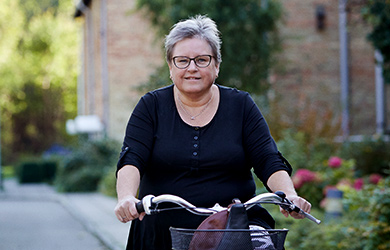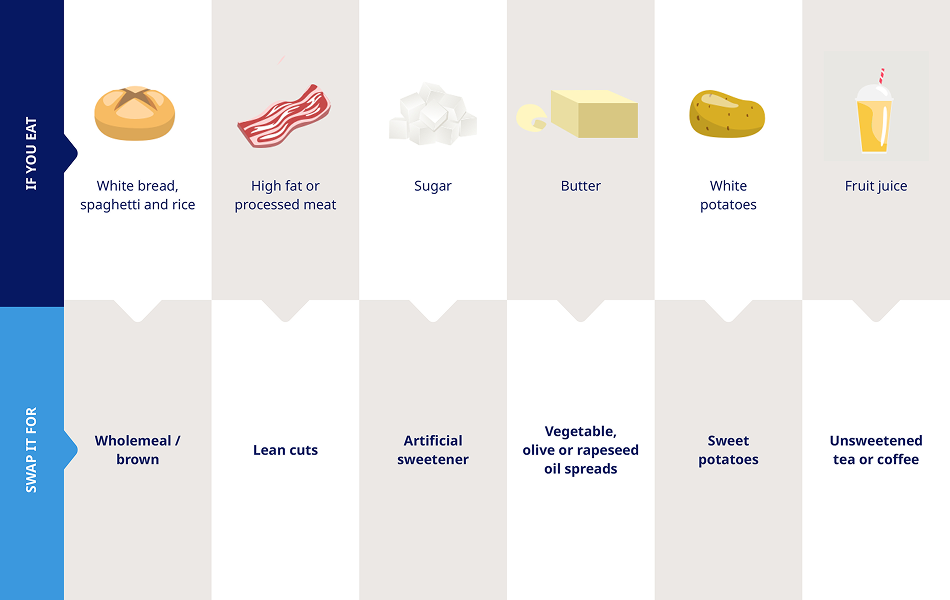
Type 2 diabetes – what's going on in your body?
Understanding the connection between insulin, blood sugar and maintaining normal levels is important for controlling type 2 diabetes.
Effective management of type 2 diabetes can help maintain quality of life for people living with the disease.1 By keeping blood sugar levels under control and managing risk factors such as excess weight, you give yourself the best chance of slowing the progression of your condition.2 This means you can stay healthier and more active for longer – but planning and a disciplined routine are needed.
Here are some key factors to help keep your type 2 diabetes under control.
Three key components of successful diabetes management include:
The balance of these factors will vary depending on the individual and where they are in their diabetes journey. Type 2 diabetes is a progressive disease3, so the management approach is likely to evolve for each person over time. For example, moving onto medication because lifestyle management alone is no longer enough should not be seen as a failure – simply a new phase of a progressive disease, with a new means of management.
Type 2 diabetes treatments: Finding the right treatment for you
The most effective way of controlling type 2 diabetes is to control blood sugar levels.4 Our blood sugar, or blood glucose, is fluctuating all the time – when we eat, drink, exercise, and metabolise. It can also be affected by psychological factors, like stress. This is true of everyone, with or without diabetes. So, a single snapshot of blood sugar at any given moment may not be a particularly useful metric. That’s where HbA1c comes in.
If you’ve been diagnosed with type 2 diabetes, you’re probably already familiar with this measurement. HbA1c is the measure of your average blood glucose levels over the past two to three months. For people with type 2 diabetes, the target level is 6.5% (48mmol/mol) or below.5
It’s an issue of balance, however, not just reduction. While the goal is to keep HbA1c below 6.5%, there is such a thing as being too low. When HbA1c drops under 4.0%, it can cause hypoglycaemia6 – or hypos – where someone with diabetes can be at risk of fainting or seizures. Prolonged low blood sugar has also been associated with an increased risk of allcause mortality compared to mid-level HbA1c.7
Controlling blood sugar requires you to be mindful of which foods you’re eating and when. For example, if you’re planning lots of physical activity, you will be able to eat more than you could on a day where you’re mostly sitting in the office or at home.

When the goal is to maintain equilibrium, it’s best to reduce or avoid intake of foods that are high in carbohydrates, fats and sugar – which is likely to cause your blood glucose levels to spike.
Excess weight and cardiovascular disease are both common risk factors for type 2 diabetes.8 High blood glucose can lead to blockages in the arteries, increasing the risk of serious cardiovascular events such as heart attack and stroke. As with controlling blood sugar levels, weight management comes down to diet, exercise, genetics, and potentially medication.9
Body Mass Index (BMI) is a common starting point for checking whether you’re in a healthy or unhealthy weight bracket. However, it’s not a sophisticated metric – as it only measures your height-to-weight ratio. So, while it provides a general snapshot of health, it can’t distinguish between muscle mass and fat, not to mention genetic predisposition.10
If you do have excess weight, the question you have to ask yourself – in consultation with your doctor – is how to make sustainable change. Usually, there are dietary changes to be made. But if you’re already eating healthily, then more exercise is a natural next step.
When the body burns more calories than it consumes, you lose weight.11 The more calories you eat, the more exercise you will need to do to maintain your weight. As with everything mentioned above, it’s all about balance. As your diabetes journey progresses, you will learn more and more about your body’s capabilities and what balance is right for you.
How to manage diabetes through exercise
Speak to your doctor to assess your risk factors and get help with your management of type 2 diabetes.
The advice is based on the writer’s experience and may deviate from professional opinion in medicine and science. Consult your doctor before making any changes to your diabetes management routines.
HQ22DI00169
1. Baghianimoghadam MH, Afkhami, Ardekani M, Baghianimoghadam B. Effect of education on improvement of quality of life by SF-20 in type 2 diabetic patients. Acta Med Indones. 2009 Oct;41(4):175-80. PMID: 20124612.
2. Rodríguez-Gutiérrez R, Montori VM. Glycemic Control for Patients With Type 2 Diabetes Mellitus: Our Evolving Faith in the Face of Evidence. Circ Cardiovasc Qual Outcomes. 2016 Sep;9(5):504-12. doi: 10.1161/CIRCOUTCOMES.116.002901. Epub 2016 Aug 23. PMID: 27553599; PMCID: PMC5031530.
3. Fonseca VA. Defining and characterizing the progression of type 2 diabetes. Diabetes Care. 2009 Nov;32 Suppl 2(Suppl2):S151-6. doi: 10.2337/dc09-S301. PMID: 19875543; PMCID: PMC2811457.
4. Bailey CJ, Day C. Treatment of type 2 diabetes: future approaches. Br Med Bull. 2018 Jun 1;126(1):123-137. doi: 10.1093/brimed/ldy013. PMID: 29897499.
5. Sandler CN, McDonnell ME. The role of hemoglobin A1c in the assessment of diabetes and cardiovascular risk. Cleveland Clinic Journal of Medicine May 2016, 83 (5 suppl 1) S4-S10; DOI: https://doi.org/10.3949/ccjm.83.s1.02
6. Ibrahim M, Baker J, Cahn A, Eckel RH, El Sayed NA, Fischl AH, Gaede P, Leslie RD, Pieralice S, Tuccinardi D, Pozzilli P, Richelsen B, Roitman E, Standl E, Toledano Y, Tuomilehto J, Weber SL, Umpierrez GE. Hypoglycaemia and its management in primary care setting. Diabetes Metab Res Rev. 2020 Nov;36(8):e3332. doi: 10.1002/dmrr.3332. Epub 2020 May 18. PMID: 32343474.
7. Inoue K, Nianogo R, Telesca D, Goto A, Khachadourian V, Tsugawa Y, Sugiyama T, Mayeda ER, Ritz B. Low HbA1c levels and all-cause or cardiovascular mortality among people without diabetes: the US National Health and Nutrition Examination Survey 1999-2015. Int J Epidemiol. 2021 Aug 30;50(4):1373-1383. doi: 10.1093/ije/dyaa263. PMID: 33378417; PMCID: PMC8562330.
8. Martín-Timón I, Sevillano-Collantes C, Segura-Galindo A, et al. Type 2 diabetes and cardiovascular disease: have all risk factors the same strength? World journal of diabetes. 2014;5:444.
9. Poznyak A, Grechko AV, Poggio P, Myasoedova VA, Alfieri V, Orekhov AN. The Diabetes Mellitus-Atherosclerosis Connection: The Role of Lipid and Glucose Metabolism and Chronic Inflammation. Int J Mol Sci. 2020 Mar 6;21(5):1835. doi: 10.3390/ ijms21051835. PMID: 32155866; PMCID: PMC7084712.
10. Nuttall FQ. Body Mass Index: Obesity, BMI, and Health: A Critical Review. Nutr Today. 2015 May;50(3):117-128. doi: 10.1097/NT.0000000000000092. Epub 2015 Apr 7. PMID: 27340299; PMCID: PMC4890841.
11. Hill JO, Wyatt HR, Peters JC. Energy balance and obesity. Circulation. 2012 Jul 3;126(1):126-32. doi:10.1161/ CIRCULATIONAHA.111.087213. PMID: 22753534; PMCID:PMC3401553.